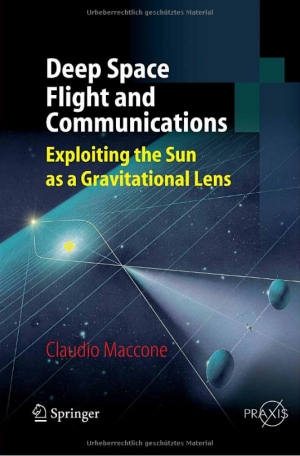Centauri Dreams
Imagining and Planning Interstellar Exploration
JPL Work on a Gravitational Lensing Mission
Seeing oceans, continents and seasonal changes on an exoplanet pushes conventional optical instruments well beyond their limits, which is why NASA is exploring the Sun’s gravitational lens as a mission target in what is now the third phase of a study at NIAC (NASA Innovative Advanced Concepts). All of this builds upon the impressive achievements of Claudio Maccone that we’ve recently discussed. Led by Slava Turyshev, the NIAC effort takes advantage of light amplification of 1011 and angular resolutions that dwarf what the largest instruments in our catalog can deliver, showing what the right kind of space mission can do.
We’re going to track the Phase III work with great interest, but let’s look back at what the earlier studies have accomplished along the way. Specifically, I’m interested in mission architectures, even as the NASA effort at the Jet Propulsion Laboratory continues to consider the issues surrounding untangling an optical image from the Einstein ring around the Sun. Turyshev and team’s work thus far argues for the feasibility of such imaging, and as we begin Phase III, sees viewing an exoplanet image with a 25-kilometer surface resolution as a workable prospect.
But how to deliver a meter-class telescope to a staggeringly distant 550 AU? Consider that Voyager 1, launched in 1977, is now 152 AU out, with Voyager 2 at 126 AU. New Horizons is coming up on 50 AU from the Earth. We have to do better, and one way is to re-imagine how such a mission would be achieved through advances in key technologies and procedures.
Here we turn to mission enablers like solar sails, artificial intelligence and nano-satellites. We can even bring formation flying into a multi-spacecraft mix. A technology demonstration mission drawing on the NIAC work could fly within four years if we decide to fund it, pointing to a full-scale mission to the gravitational focus launched a decade later. Travel time is estimated at 20 years.
These are impressive numbers indeed, and I want to look at how Turyshev and team achieve them, but bear in mind that in parsing the Phase II report, we’re not studying a fixed mission proposal. This is a highly detailed research report that tackles every aspect of a gravitational lens mission, with multiple solutions examined from a variety of perspectives. One thing it emphatically brings home is how much research is needed in areas like sail materials and instrumentation for untangling lensed images. Directions for such research are sharply defined by the analysis, which will materially aid our progress moving into the Phase III effort.

Image: A meter-class telescope with a coronagraph to block solar light, placed in the strong interference region of the solar gravitational lens (SGL), is capable of imaging an exoplanet at a distance of up to 30 parsecs with a few 10 km-scale resolution on its surface. The picture shows results of a simulation of the effects of the SGL on an Earth-like exoplanet image. Left: original RGB color image with (1024×1024) pixels; center: image blurred by the SGL, sampled at an SNR of ~103 per color channel, or overall SNR of 3×103; right: the result of image deconvolution. Credit: Turyshev et al.
Modes of Propulsion
A mission to the Sun’s gravity lens need not be conceived as a single spacecraft. Turyshev relies on spacecraft of less than 100 kg (smallsats, in the report’s terminology) using solar sails, working together and produced in numbers that will enable the study of multiple targets.
The propulsive technique is a ‘Sundiver’ maneuver in which each smallsat spirals in toward perihelion in the range of 0.1 to 0.25 AU, achieving 15-25 AU per year exit velocity, which gets us to the gravity lensing region in less than 25 years. The sails are eventually ejected to reduce weight, and onboard propulsion (the study favors solar thermal) is available at cruise. The craft would enter the interstellar medium in 7 years as compared to Voyager’s 40, making the journey to the lens in a timeframe 2.5 times longer than what it took to get New Horizons to Pluto.
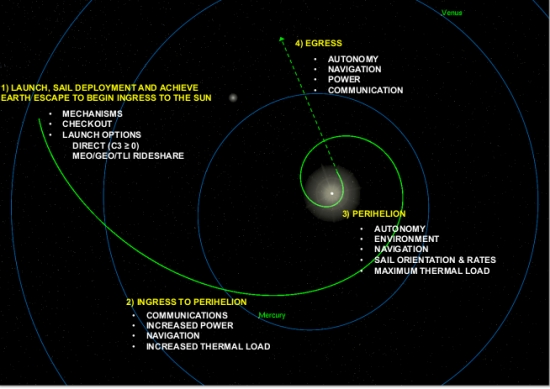
Image: Sailcraft example trajectory toward the Solar Gravity Lens. Credit: Turyshev et al.
The hybrid propulsion concept is necessary, and not just during cruise, because once in the focal lensing region, the spacecraft will need either chemical or electrical propulsion for navigation corrections and for operations and maintenance. Let’s pause on that point for a moment — Alex Tolley and I have been discussing this, and it shows up in the comments to the previous post. What Alex is interested in is whether there is in fact a ‘sweet spot’ where the problem of interference from the solar corona is maximally reduced compared to the loss of signal strength with distance. If there is, how do we maximize our stay in it?
Recall that while the focal line goes to infinity, the signal gain for FOCAL is proportional to the distance. A closer position gives you stronger signal intensity. Our craft will not only need to make course corrections as needed to keep on line with the target star, but may slow using onboard propulsion to remain in this maximally effective area longer. I ran this past Claudio Maccone, who responded that simulations on these matters are needed and will doubtless be part of the Phase II analysis. He has tackled the problem in some detail already:
“For instance: we do NOT have any reliable mathematical model of the Solar Corona, since the Corona keeps changing in an unpredictable way all the time.
“In my 2009 book I devoted the whole Chapters 8 and 9 to use THREE different Coronal Models just to find HOW MUCH the TRUE FOCUS is PUSHED beyond 550 AU because of the DIVERGENT LENS EFFECT created by the electrons in the lowest level of the Corona. For instance, if the frequency of the electromagnetic waves is the Peak Frequency of the Planckian CMB, then I found that the TRUE FOCUS is 763 AU Away from the Sun, rather than just 550 AU.
“My bottom-line suggestion is to let FOCAL observe HIGH Frequencies, like 160 GHz, that are NOT pushing the true focus too much beyond 550 AU.”
Where we make our best observations and how we keep our spacecraft in position are questions that highlight the need for the onboard propulsion assumed by the Phase II study.
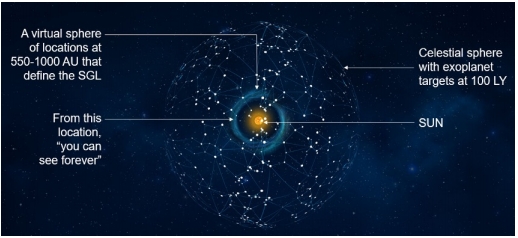
Image: Our stellar neighborhood with notional targets. Credit: Turyshev et al.
For maximum velocity in the maneuver at the Sun, as close a perihelion as possible is demanded, which calls for a sailcraft design that can withstand the high levels of heat and radiation. That in turn points to the needed laboratory and flight testing of sail materials proposed for further study in the NIAC work. Let me quote from the report on this:
Interplanetary smallsats are still to be developed – the recent success of MarCO brings them perhaps to TRL 7. Solar sails have now flown – IKAROS and LightSail-2 already mentioned, and NASA is preparing to fly NEA-Scout. Scaling sails to be thinner and using materials to withstand higher temperatures near the Sun remains to be done. As mentioned above, we propose to do this in a technology test flight to the aforementioned 0.3 AU with an exit velocity ~6 AU/year. This would still be the fastest spacecraft ever flown.
The report goes on to analyze a technology demonstration mission that could be done within a few years at a cost less than $40 million, using a ‘rideshare’ launch to approximately GEO.
String of Pearls
The mission concept calls for an array of optical telescopes to be launched to the gravity lensing region. I’ll adopt the Turyshev acronym of SGL for this — Solar Gravity Lens. The thinking is that multiple small satellites can be launched in a ‘string of pearls’ architecture, where each ‘pearl’ is an ensemble of smallsats, with multiple such ensembles periodically launched. A series of these pearls, multiple smallsats operating interdependently using AI technologies, provides communications relays, observational redundancy and data management for the mission. From the report:
By launching these pearls on an approximately annual basis, we create the “string”, with pearls spaced along the string some 20-25 AU apart throughout the timeline of the mission. So that later pearls have the opportunity to incorporate the latest advancements in technology for improved capability, reliability, and/or reductions in size/weigh/power which could translate to further cost savings.
In other words, rather than being a one-off mission in which a single spacecraft studies a single target, the SGL study conceives of a flexible investigation of multiple exoplanetary systems, with ‘strings of pearls’ launched toward a variety of areas within the focus within which exoplanet targets can be observed. Whereas the Phase I NIAC study analyzed instrument and mission requirements and demonstrated the feasibility of imaging, the Phase II study refines the mission architecture and makes the case that a gravity lens mission, while challenging, is possible with technologies that are already available or have reached a high degree of maturity.
Notice the unusual solar sail design — called SunVane — that was originally developed at the space technology company L’Garde. Here we’re looking at a sail design based on square panels aligned along a truss to provide the needed sail area. In the Phase II study, the craft would achieve 25 AU/year, reaching 600 AU in ~26 years (allowing two years for inner system approach to the Sun). [Note: I’ve replaced the earlier SunVane image with this latest concept, as passed along by Xplore’s Darren Garber. Xplore contributed the design for the demonstration mission’s solar sail].

Image: The SunVane concept. Credit: Darren D. Garber (Xplore, Inc).
The report examines a sail area of 45,000 m2, equivalent to a ~212×212 m2 sail, with spacecraft components to be configured along the truss. Deployment issues are minimal with the SunVane design. The vanes are kept aligned edge-on to the Sun as the craft approaches perihelion, then directed face-on to promote maximum acceleration.
We have to learn how to adjust parameters for the sail to allow the highest possible velocity, with areal density A/m being critical — here A stands for the area in square meters of the sail, with m as the total mass of the sailcraft in kilograms (this includes spacecraft plus sail). Sail materials and their temperature properties will be crucial in determining the perihelion distance that can be achieved. This calls for laboratory and flight testing of sail material as part of the continuing research moving into the Phase III study and beyond. Sail size is a key issue:
The challenge for design of a solar sail is managing its size – large dimensions lead to unstable dynamics and difficult deployment. In this study we have consider[ed] a range of smallsat masses (<100 kg) and some of the tradeoffs of sail materials (defining perihelion distance) and sail area (defining the A/m and hence the exit velocity…). As an example, for the SGLF mission, consider perihelion distance of 0.1 AU (20Rsun) and A/m=900 m2/kg; the exit velocity would be 25 AU/year, reaching 600 AU in ~26 years (allowing 2 years for inner solar system approach to the Sun). The resulting sail area is 45,000 m2, equivalent to a ~212×212 m2 sail.
The size of that number provokes the decision to explore the SunVane concept, which distributes sail area in a way that allows spacecraft components to be placed along the truss instead of being confined to the sail’s center of gravity, and which has the added benefit of high maneuverability. A low-cost near-term test flight is proposed with testing of sail material and control, closing to a perihelion in the range of 0.3 AU, with an escape velocity from the Solar System of 6-7 AU per year. Several such spacecraft would enable a test of swarm architectures.
Thus the concept: Multiple spacecraft would be launched together as an ensemble — the ‘pearl’ — using solar sails deployed on each and navigating through the Deep Space Network, with the spacecraft maintaining a separation on the order of 15,000 km as they pass through perihelion. Such ensembles are periodically launched, acting interdependently in ways that would maximize flexibility while reducing risk from a single catastrophic failure and lowering mission cost. We wind up with a system that would enable investigations of multiple extrasolar systems.
I haven’t had time to get into such issues as communications and power for the individual smallsats, or data processing and AI, all matters that are covered in the report, nor have I looked in as much detail as I would have liked at the sail arrays, envisioned through SunVane as on the order of 16 vanes of 103 m2, allowing the area necessary in a configuration the report considers realistic. This is a lengthy, rich document, and I commend it to those wanting to dig further into all these matters.
The report is Turyshev et al., “Direct Multipixel Imaging and Spectroscopy of an Exoplanet with a Solar Gravity Lens Mission,” Final Report NASA Innovative Advanced Concepts Phase II (full text).

The FOCAL Radio Bridge
Getting a probe to another star is a big enough problem, but woven inextricably through it is the issue of communications. Adding payload steepens the propulsion curve in dramatic fashion, which is why recent thinking has dwelled so firmly on miniaturizing the spacecraft. Thus Breakthrough Starshot, which envisions payloads roughly on the order of a computer chip. No wonder, with spacecraft of that size, getting data back to Earth is such a daunting challenge.
Can gravitational lensing help? We’ve seen that the Sun’s mass shapes spacetime around it, bending light from targets on the other side so that electromagnetic waves come to a focal point about 550 AU out. The implications for imaging are under intense study at the Jet Propulsion Laboratory, where Slava Turyshev’s team, working with a Phase III NIAC grant, is exploring “Direct Multipixel Imaging and Spectroscopy of an Exoplanet with a Solar Gravitational Lens Mission,” taking two prior studies, a Phase I and II at NIAC, forward in terms of imaging.
But if we can fight off solar corona effects and achieve a signal-to-noise ratio high enough — Turyshev believes this is possible — we might do more than reconstructing an exoplanet image with 25-kilometer scale surface resolution. Such an image would help us understand the target for future interstellar probes, but Claudio Maccone has been writing about using the same lensing effect to boost communications in dramatic fashion. And if Starshot’s payloads might have little more than a cellphone’s available power, such levels might prove workable.
The Gravitational Lens as Relay
How is this possible? There are a lot of issues here, but we can start with Bit Error Rate, which has to do with the quality of a signal. Specifically, BER is the number of erroneous bits received divided by the total number of bits transmitted. We can compare the Bit Error Rate across interstellar distances with and without the gravitational lens effect, as Maccone first did in a 2011 paper. I’m going to use that paper and his recent presentation to examine the results and what they mean for current thinking about missions.
Before we start miniaturizing, let’s assume a probe at Alpha Centauri communicating to Earth using a 12-meter antenna, a fairly conventional spacecraft working with a Deep Space Network-class antenna (a 70-meter dish) on the other end, trying to communicate over the Ka band (32 GHz), with a bit rate of 32 kpbs. These assumptions come from recent missions: The Ka band is the highest frequency used by Cassini, while the 32 kbps bit rate equals that of ESA’s Rosetta spacecraft. Maccone then goes on to assume transmitting power of 40 W.
The paper (citation below) is available in full text, so there is no need to go through the chain of reasoning in detail here. The point is that the signal is shown to be unusable. But matters change if we deploy a FOCAL mission to the Sun’s gravity lens. According to the paper’s equations, the same equipment now allows received power and acceptable Bit Error Rate at Alpha Centauri. Thus the figure below, which Maccone used in his online talk.
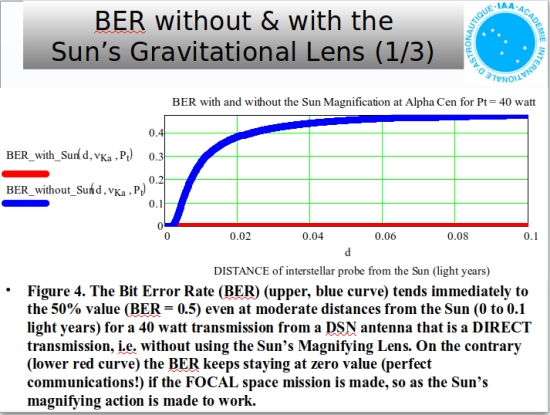
If we follow the equations through, we don’t begin to introduce significant errors until we’re fully 9 light years out, not far off the distance to Epsilon Eridani. By the time we get to a probe at a distance of 100 light years, we reach a level of Bit Error Rate high enough to swamp the dataflow with this equipment. A spacecraft using the Sun’s gravitational lens, then, can communicate effectively assuming present-day power levels and infrastructure with a probe at Alpha Centauri, making the target of 550 AU an enabler for data return from small payloads.
If Breakthrough Starshot had a gravitational lens relay of this kind, the daunting communications issue would be cast in a new light. Just how complicated communications matters are without a gravity lens relay is something I’ll soon explore with a look at the just released Request for Proposals from Breakthrough that deals explicitly with the question.
Enter the Radio Bridge
What is it that S.R. Hadden says in the film Contact? “The first rule of government spending: why build one, when you can build two, at twice the price?” This is where Claudio Maccone is suggesting a forward path for interstellar probes that looks at what we do next after our initial interstellar probes fly past their target. The Starshot model, for example, assumes a fleet of sail-driven craft flung past a nearby star like Proxima Centauri to collect and return an image of the planets there. This is a flyby concept. A few hours in-system and gone.
Flybys are first steps and, as New Horizons has recently shown so dramatically (not to mention a host of other craft, like Voyager in the past), we can collect invaluable data from them. But once we’ve achieved flybys around nearby stars, we’ll want to continue our explorations by establishing a robotic (or one day human, perhaps) presence there. Now we would like not just the relatively slow communications methods enabled by the gravitational lens of the Sun but a much faster capability. We achieve this by using a second lens, the one near our target star.
If we’re talking about a mission to Alpha Centauri, then we go to the gravitational lens of Centauri A because it has the highest mass of the three stars, and thus offers the highest gain. Here the FOCAL spacecraft would be placed at a minimum distance of 750 AU for communications and data retrieval from targets around any one of the three stars. We have a radio bridge with communications capabilities that can be achieved by no other means. Here is the image Maccone uses to illustrate the point, along with his own caption from the paper.
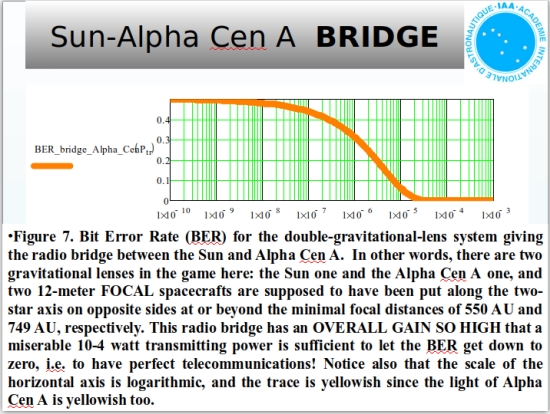
If we establish the radio bridge, our capabilities at error-free communications between the Sun and Alpha Centauri, assuming two 12-meter FOCAL antennae, become striking: The minimum transmitted power falls to 10-4 watts. One-tenth of a milliwatt does the job, creating error-free communications between spacecraft and Earth, meaning we have created a workable channel for future activities in the Alpha Centauri system, whether human or robotic.
To make it happen, an initial FOCAL mission becomes our communications relay, while a second FOCAL mission creates the radio bridge. Multiple human generations may separate the two projects; this is not a task for the impatient. But should we see it through, huge, power hungry communications systems aboard the spacecraft are not necessary, while communications with our growing infrastructure around nearby stars become robust and all but routine.
Building radio bridges is a huge challenge, assuming not only the capability of reaching and exploiting the Solar gravity lens, but eventually reaching another star not just with a flyby but with a craft capable of decelerating into the target system and positioning itself into the focal lens of the star there. The sequence may be straightforward: Use our Sun’s gravity lens to communicate with the first interstellar probes, then expand capability by setting up the second communications relay. But the implementation, like everything interstellar, pushes all our limits well beyond anything we have yet achieved. Which is why I love writing about all this.
Technologies both suggest and enable new uses that push beyond the currently possible. If there is one thing my continuing dreams of Alpha Centauri have taught me, it’s that thinking beyond our own personal limitations builds the groundwork for future generations.
The idea that we should think only of what we as individuals will benefit from misses the point of intellectual inquiry, and blunts the blade of discovery. So I applaud the efforts of those currently working the hard equations of reaching 550 AU, even though many of them will probably not see such a mission arrive. Being a part of the effort, emplacing cornerstones, is what counts.
The paper is Maccone, “Interstellar Radio Links Enhanced by Exploiting the Sun as a Gravitational Lens,” Acta Astronautica Vol. 68, Issues 1-2 (January-February 2011), pp. 76-84 (abstract/full text).

Developing FOCAL Mission Concepts
In the early summer of 2005, I found myself, thanks to the efforts of Greg Matloff and Princeton’s Ed Belbruno, in Princeton for a conference called New Trends in Astrodynamics and Applications II, which Dr. Belbruno had organized. I was to give a brief talk at the end of the session summarizing what was going on in the interstellar travel community. Two days of chill rain didn’t dampen my enthusiasm at seeing Greg and his wife, the artist C Bangs, as well as Belbruno himself, who had been a great help as I put together my Centauri Dreams book. And on the morning of the first day of the conference, I joined Greg, C and Claudio Maccone for breakfast at the Nassau Inn, Princeton’s lovely colonial era hostelry.
I’ve since had the opportunity to talk with Dr. Maccone many times at conferences, and one year enjoyed memorable meals with him in the Italian Alps, but that first encounter really sticks in my mind. I had been thinking about gravitational lensing for several years, but it was only through studying Maccone’s writings that I began to fathom what the idea represented. Suddenly I found myself having breakfast with the man who had made a mission to the Sun’s gravitational lens a cornerstone of his professional life. What a way to start the Princeton conference!
Here was an opportunity offered up by nature to achieve extraordinary magnifications. It would be a natural lensing available to any civilization that could reach the gravity focus of its star, which for the Sun means about 550 AU. As the focal line extends to infinity, studies at various wavelengths are enabled as the spacecraft continues its departure from the Solar System.
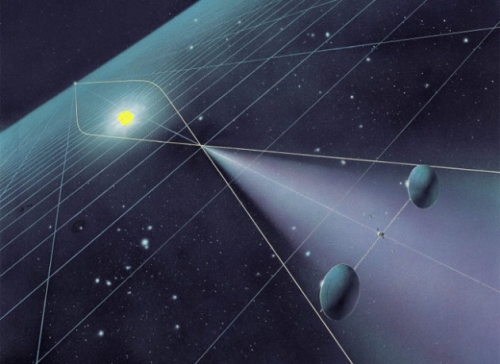
Image: The FOCAL mission as described by Claudio Maccone in his 2009 book Deep Space Flight and Communications (Springer).
Let’s dwell on that a moment. The goal in a mission to the gravitational lens — Maccone calls the concept FOCAL, which is what I will use as we talk about the topic in the next few days — would not be to reach 550 AU and stay there. The gravitational focus is not like an optical lens, where light diverges after the focus. Instead, as light from the other side of the Sun is focused by the Sun’s gravitational field, it remains fixed along the focal axis. Every point along the straight line trajectory beyond 550 AU remains a focal point.
So if you want to image a target, you move toward 550 AU precisely opposite to the target you want to image, putting the Sun between you and it. Think Alpha Centauri, for example, where a close look at Proxima Centauri b would be exceedingly useful as projects like Breakthrough Starshot ponder sending probes there. The gain for optical radiation from the planet would be amplified by a factor of 1011. Now think of the uses not just in imaging but in astronomy at a wide range of wavelengths. FOCAL would be a true interstellar precursor.
Assuming, of course, that you could untangle the image. The planet we want to study is, after all, spread out into an Einstein ring surrounding the Sun. More on this in a moment.
Beyond imaging, the communications potential for the gravity lens is intriguing and enabling. I’ll pause to note that the history of gravitational lens mission ideas even includes a SETI aspect. Back in the 1990s, drawing on work at the Italian aerospace company Alenia Spazio, Greg Matloff examined an inflatable radio telescope called Quasat, which became the subject of regular meetings in that decade. All this ties in with the extensive Italian investigation of solar sail ideas that I’ve discussed before in these pages, work informed by the efforts of physicists like Giovanni Vulpetti, Maccone himself, Giancarlo Genta, and the continuing work of Matloff.
Matloff explored solar sailing to reach the gravitational focus in a 1994 paper (“Solar Sailing for Radio Astronomy and SETI: An Extrasolar Mission to 550 AU,” Journal of the British Interplanetary Society Vol. 47, pp. 476-484), where sails enabled placement of a probe at the gravity lens whose observations ranged through radio astronomy and into SETI.
I mentioned Von Eshleman’s work back in the 1970s, which to my knowledge was the first time anyone proposed an actual mission to 550 AU and beyond to study the Sun’s gravitational lens. It took just over a decade for the concept to take deep root and spawn a mission concept.
For it was in 1992 that Claudio Maccone began discussing a FOCAL mission at a conference in Torino, and in 1993 he went on to submit a formal proposal to the European Space Agency for the funding needed to firm up a mission design. Meanwhile, he was identifying issues that needed to be addressed. The 550 AU distance may be a bare minimum, given the problem of distortion caused by the Sun’s corona. But the farther the probe travels from the Sun, the less the coronal effect, and with a focal line extending to infinity, we have room to maneuver.
A FOCAL mission is quite an interesting problem for spacecraft design, one that Maccone subsequently addressed in his Deep Space Flight and Communications (Springer, 2009). There he advocated using tethers to deploy two antennae, each tether several kilometers in length, allowing a larger, more detailed field of view than one provided by a single antenna. If these methods work, we still have a very difficult image to untangle. Potentially, we could look at details on a planetary surface even at the distance of Proxima b, studying these with a mission that is 278 times closer than the actual distance to the target. But about that image…
Geoffrey Landis has analyzed the problems we’ll face in using the Sun as a ‘gravitational telescope’ when trying to image the surface of an exoplanet. The issues are manifold, and include pointing and focal length at these magnifications, signal-to-noise ratio involving the Sun’s corona, and what he calls ‘focal blur,’ which seems inherent in the nature of gravitational lensing. All of this in a significant paper titled “Mission to the Gravitational Focus of the Sun: A Critical Analysis,” which addresses matters that are also being examined in NASA’s latest NIAC study. JPL’s Slava Turyshev is principal investigator on that one, an unusual Phase III grant called “Direct Multipixel Imaging and Spectroscopy of an Exoplanet with a Solar Gravitational Lens Mission.” The concept has already gone through two prior rounds of development.

Image: Artist’s depiction of a possible image from a Solar Gravitational Lens (SGL) telescope. Credit: Slava Turyshev.
But I’m getting ahead of myself, and deep into unknowns under current investigation. Let’s talk in the next post, then, about using the gravitational lens for communications. It’s a fascinating option for efforts like Breakthrough Starshot, in which getting a signal back to Earth from tiny payloads is an obvious concern. Just what, then, is a radio bridge, and how does Claudio Maccone hope to use one to put a significantly different spin on missions like Starshot? I’ll also have thoughts on the NASA effort and the continuing mission design within NIAC.
Note: Geoffrey Landis also presented a later version of his work on the lens in a 2017 conference paper for the Tennessee Valley Interstellar Workshop, “A Telescope at the Solar Gravitational Lens: Problems and Solutions” (full text). This paper, along with another by Slava Turyshev on imaging issues, is also available in the conference’s proceedings volume.

Claudio Maccone: A Deep Dive into Gravitational Lensing
Sorry for the server problems the last few days, which resulted in some tinkering under the hood by people far more skilled at such things than I am. Meanwhile, those experiencing deja vu at seeing this post should take heart — there is a simple explanation. Last week I posted an earlier article about Claudio Maccone’s upcoming presentation on gravitational lensing and the FOCAL mission to exploit it, but had to withdraw the post when I realized the live session, a ‘webinar’ organized by Ravi Kumar Kopparapu (NASA GSFC) and Jacob Haqq Misra (Blue Marble Space Institute of Science), might not be available beyond a restricted audience.
Once that was straightened out, the meeting had already occurred, but fortunately Dr. Maccone’s session was recorded and is now available here. I’m going to go ahead and run the rest of that earlier post now, because most people didn’t see it. Even so, and despite the fact that it was only up on the site for a few minutes, that turned out to be long enough for it to propagate, without my realizing it, to several thousand people on the email list, which is why I have to pause to explain all this.
As for Claudio Maccone, the FOCAL mission, and future uses of this resource, a few thoughts. The Sun’s gravitational lens became something of an obsession of mine when I first learned about it in the 1990s. Although the physics of gravitational lensing became apparent in Einstein’s work, and was indeed studied by him, it would take several decades before Sydney Liebes at Stanford worked out the mathematics and showed how a galaxy between us and a more distant quasar could focus the light of the quasar in ways astronomers could observe.

The Stanford connection persisted in the work of Von Eshleman, who as far as I know was the first to delve into whether our own Sun could be used in much the same way. As astronomers explored the concept in the 1980s, Dr. Maccone went on to conceive of a mission that could exploit lensing. The Sun bends the light of an object directly behind it (in terms of the observer) in such ways that potential magnifications are huge. Could we put a spacecraft into range of the gravitational lens (beginning at 550 AU and extending outward), to achieve unprecedented magnification at various wavelengths of another stellar system?
Image: Claudio Maccone, in a photo I snapped at one of the Breakthrough Discuss meetings in Palo Alto.
I hope you’ll watch the presentation, which ranges over all aspects of gravitational lensing that Dr. Maccone has addressed in his papers and books, including not only the implications for astronomy but also the potential for using lensing to boost communications from distant interstellar probes. Anyone interested in deep space astronomy and communications will find this a cutting-edge topic, and as you might expect, one that inspires controversy. The lensing effect is real. The key issue: Can we exploit it with near-term technologies?
The FOCAL mission that Dr. Maccone explores in his book Deep Space Flight and Communications: Exploiting the Sun as a Gravitational Lens (Springer Praxis, 2009) and subsequent papers is a deep dive into the hardware required to find the answer.
You can imagine why an effort like Breakthrough Starshot would find gravitational lensing as interesting as it does. If we could coax huge gain out of this natural lens, we could examine a star system like Alpha Centauri at close range long before sending a spacecraft there. And once deployed, even the tiny craft envisioned by Breakthrough Starshot would have the potential for returning data to Earth via a communications ‘bridge’ enabled by lensing. Other astronomical uses of gravitational lensing are, as you might imagine, numerous (I for one would like to know what a FOCAL mission might achieve in studying the Cosmic Microwave Background).
Tomorrow I want to dig into some of these issues, beginning with memories of a breakfast at Princeton back in 2006 that I shared with Greg and C Matloff, where I first met Dr. Maccone.

Server Problems Resolved
I’m going to keep Alex Tolley’s fine essay (below) at the top for another day, in hopes of re-starting the comment thread that was going along so nicely before the site went down. Then tomorrow we’ll start talking about gravitational lensing, in the first of a series that may extend until next week.
Distinguishing Between Biological and Machine Civilization Techno-signatures
If we ever make a SETI detection, will it be of biological beings or machine intelligence? As Alex Tolley explains in today’s essay, there are reasons for favoring the latter possibility, leading our author to compose what he calls a ‘light-hearted speculation’ about machines searching for other civilizations of their own kind. Life seems to be easy compared to this. We are developing the tools to delve into planetary atmospheres in search of biosignatures, hoping to cull out ambiguities. But is there an equivalent in the machine world of a biosignature, and how would it be found? Interesting implications arise, some of them seemingly close to home.
by Alex Tolley

Curiosity Rover. Credit Nasa.
Terry Bisson’s amusing short sci-fi story “They’re made Out of Meat” [4], is a communication between two individuals who express their disbelief that a biological species (detected on Earth by a galactic survey) can possibly be intelligent. The denouement is to erase the record of discovery from the survey report. It remains one of the few stories where machine entities are dominant in the galaxy. For me, this story is memorable because it is one of so few stories that focuses on the viewpoint of aliens, and moreover, machine aliens. This essay similarly focuses on what a machine civilization would look for when searching for machine intelligence in space.
Until recently, most speculation about extraterrestrial intelligence (ETI) has assumed it will be biological. In science fiction from the venerable H. G. Wells’ novel The War of the Worlds to recent movies like Independence Day and Arrival, technologically advanced ETI is depicted as biological.
SETI starts with the probability that life will appear, first unicellular then complex, leading on Earth led to hominid-level intelligence, which in turn eventually flowered culturally and created civilization and technological societies. SETI assumed there would be some sort of galactic communication between biological species confined to their home systems due to the extreme difficulties of interstellar travel.
Our civilization has placed primacy on our cognitive level to ensure we are the prime agencies, using animals, and later machines, to displace physical labor. Our conceit is that this will always remain so, as our technologies increase their capabilities, but always remain controlled by us.
However, the rapid development of artificial intelligence (AI) since the middle of the 20th century, the continuing rapid performance improvement in computer systems, and the undeniable success and longevity of our robotic explorers in space should be an indication that we are in the throes of a rapid transition to true, artificial general intelligence (AGI) machines that are well adapted to inhospitable environments, especially space.
Sci-fi authors have explored these machine-centric futures, from the novel by Stephen Baxter and Alastair Reynolds The Medusa Chronicles [2], which extended the Arthur C Clarke novelette [3] and has machines building a competing civilization to humans in the outer solar system, to Greg Benford’s Galactic Center novels, where sentient machines dominate the galaxy and humans have to survive like mice in a human world, while the mechs try to eliminate the humans just as we do for small rodents in our buildings.
More recently, James Lovelock wrote that he believed that humans would be replaced by cyborgs, by which he meant not Martin Caidin’s Cyborg (AKA The Six-million Dollar Man) or Star Trek‘s Borg, but intelligent robots [1]. These would be our descendents and would be the explorers of the galaxy. This view has been supported by the Astronomer Royal, Sir Martin Rees, who stated that he believes that if we receive communication from the stars, it will be from a machine civilization [5]. Sir Martin is old enough to have watched the BBC production of A for Andromeda and the sequel The Andromeda Breakthrough, where it is revealed that the source of the radio signal might have been a machine intelligence.
Space advocates continue to argue over human versus robotic exploration of space, which usually proceeds around the superiority of human capabilities compared to robotic probes, especially surface rovers. What is rarely discussed is that this is a dynamic situation, where the improvement in capabilities favors robots far more than humans. Astronomer Royal Rees is surprised this argument still continues, as he sees robotic exploration, primarily for science, as clearly advantageous over human exploration. The farther away that exploration extends from the Habitable Zone (HZ), the more difficult to reach and inhospitable the targets become.
Some, like Jupiter’s inner moons, have radiation levels so high that even robotic probes need specially hardened microchips and circuits. Reaching the outer planets is so time consuming that without drives that are orders of magnitude more powerful than today’s, or hibernation technology, human travel will be particularly arduous. Such trips will make even the global sea voyages in the Age of Exploration seem like child’s play by comparison. The only advantage such travellers will have over Captain Cook is that there will be no hostile natives to meet them.
Let me be clear, I do not expect humans to be displaced by robots on Earth, at least not in the foreseeable future, nor will there be a binary pure biological human vs robot future. Humans will take advantage of modifications using technologies with increasing capabilities that will help us compete with robots, as well as modifications at the biological level incorporating genetic engineering. As computers have moved from dedicated buildings to the desktop to mobile devices, wearable devices will eventually become implanted, interfacing with the appropriate neural circuitry, and in some cases, replacing human organs. Genetic engineering is at its infancy and we can expect rapid developments once the moral objections are overcome.
I would argue that most biological extraterrestrial intelligences (ETIs) will follow a similar path, as they have evolved to live in a biological environment and not an off-world one. In other words, technological evolution will converge on embodied machine intelligence.
A Machine Diaspora
In the short term, well in advance of human brains becoming artificial, artificial minds will be rapidly deployed in many settings. They will likely be the only types of minds in deep space vehicles. Such minds will not just be embodied in probes and rovers, but also in industrial facilities to mine resources from asteroids and planets. They will likely be specialized and interact with other specialized robots to build industrial ecosystems and eventually their own colonies and civilizations. The barriers to humans colonizing space so easily will allow such robot civilizations to develop [semi]independently from humanity.
If robots are the best embodiment of minds to travel in space, explore and colonize it, then it seems most probable that they will be the first emissaries to other star systems. They may well prove the only travelers, with biological species trapped within their home systems, and possibly just to their homeworld, a few planets and moons, and space habitats. If the Breakthrough Starshot project ever launches sailcraft, the crude minds in the vessel will be the first of many AI interstellar emissaries.
World ships or seed ships carrying humans to the stars may eventually happen, but the populations may find robots have fully developed the possible target systems and are not particularly interested in “carbon-based units” potentially parasitizing their artificial environments.
If these prognostications prove right and machine intelligences become our descendants and dominate the galaxy, it seems reasonable to speculate that the same has happened on other worlds where biological intelligence has evolved. Whether this has happened elsewhere or not, machine descendants will also be searching space for others like themselves. If so, the question I want to pose is:
How would such a machine civilizations look for similar signs of a machine civilizations in the galaxy?
Because machine life is dependent on the earlier evolution of intelligent biological life, any technological signature we detect, from electromagnetic wave signals to manufactured artifacts, could be the result of either a biological or machine intelligence.
For a machine intelligence looking for other machine intelligence in the galaxy, this presents an ambiguity over agency. For techno-signatures from a world in the HZ, the earlier evolution of biological intelligence may indicate a reduced probability of machine intelligence compared to biological intelligence. However, over the long term, if machines inevitably displace biological intelligence, then the probability rises. Once interstellar exploration is under way, then the probability of any civilization being machine-based rises very quickly towards unity, as suggested by Sir Martin Rees.
For a machine civilization looking for other machine civilizations, are there ways to rule out biological civilizations from machine ones, or are the two indistinguishable?
The range of possible techno-signatures would be ones we already know to look for. Planetary surface structures, platonic shapes, processed surface materials like metals, radio emissions with spectrum spikes, signals with non-random patterns, space-based structures, artificial structures that require energy to move in space, industrial gases in the atmosphere such as chlorofluorocarbons. All these techno-signatures may be accompanied by biosignatures, especially from a habitable planet in the HZ with an atmosphere.
The foregoing should make it clear that sentient machines will have a harder time searching for their machine cousins than humans have for searching for life and intelligence of any sort. Biosignatures will indicate life. Techno-signatures can indicate technological civilization of either biological or artificial origin. Just as we cannot separate biological and machine civilizations remotely today or even in the near future, neither can a machine civilization, unless their technology allows remote observations to make these distinctions. Below I outline some scenarios, many of which require a local probe.
Machines Searching for Machines
So let us assume a machine civilization that is colonizing the galaxy is looking to make contact with other machine civilizations. This civilization will know that it was preceded by at least one biological intelligent species that developed a technological civilization that spawned its ancestors before being replaced.
The extra ambiguity faced by such a civilization is distinguishing between a biological and machine civilization. Because of the length of galactic time, I will assume that any period of transition will be transient and therefore has a low probability of being encountered. Either the biological intelligence will have retained control [11] or the transition to a machine civilization will be complete. The current view of techno-utopians that humans will use advanced AI technologies to increase their capabilities to stave off any machine takeover will therefore be relegated to a transient transition period, one that will eventually either have to be abandoned or will lead to a machine civilization that will supplant human civilization.
With this in mind, what signatures will a machine civilization look for that will lead it to conclude that it has found a machine civilization that is independent of any previous biological civilization?
We start with the assumption that a techno-signature of some type has been detected [7].
The most convincing support for a machine civilization would be the absence of any biosignature in the system, or the planet nearest the source of the signature. A sterile planet with a techno-signature would indicate that any biological intelligence was either never located there, or that it has been systematically eliminated with all other life. Such a sterile planet would have an atmosphere gas composition in equilibrium, which would also eliminate unseen microbes. However, there could still be some ambiguity as to whether the techno-signature implies an extant civilization or not. Structures and even a transmitting beacon might imply a dead civilization that had disappeared with all other life. If there are biosignatures elsewhere in the system, it could indicate that the techno-signature is a product of a biological intelligence on that world, with machines providing the needed capabilities elsewhere in the system. Humans might have METI transmissions from the lunar farside as an example of such a scenario.
Now suppose that the source of the techno-signature is from or near a planet that has been confirmed as having no complex life forms. This lack of complex life forms might be determined telescopically (spectroscopically and visually) by noting a barren continental surface devoid of plants. An absence of plants also implies an absence of a terrestrial food chain and therefore no intelligent biological intelligences. It would take a local probe to eliminate oceanic complex life, and eliminate any possibility of an intelligent technological species that lived in the ocean, but came out onto the land to develop a fire-based technology, perhaps as the Europans may have been doing in Clarke’s Odyssey series. As with the lifeless planet scenario, there remains the issue of whether the civilization is extant or not.
The next case is that there is a planet in the system that has a biosignature and clear signs of complex life such as biomes with plant-based ecosystems. Human civilization to date, that is the last ten millennia or so, has required agriculture. This has resulted in field cultivation, primarily of monoculture crops. Often these fields are regular in shape, and may form a patchwork of different monocultures. Field boundaries also tend to be straight. Even if this is not a universal method of farming (e.g. hillside rice paddies, or domesticated animal ranching), any evidence of such monocultures in what appear to be unnatural delineated areas would be a probable indication of the presence of biological intelligence.
This biosignature would still be ambiguous and need further exploration. On Earth, our human population is limited by food production, a Malthusian condition that we seem to be coming up against again after a brief period of being free of that condition. We have extended the productivity of land for food production with artificial fertilizers, and we are just starting to increase it much farther using artificial light in vertical farms. Earth could, in theory, support a much larger population if traditional farming in spaces open to sunlight was replaced by these vertical farms, and even factory food production using other fast replicating food sources such as single celled organisms, insects, and cell culture. In extremis, the agriculture signature would disappear, leaving just the techno-signature of extensive cities.
The other possibility is a machine civilization that has allowed human populations to remain in existence, but removed from control. We might think of this as the movie version of Planet of the Apes, but where machines are the dominant civilization, and humans reduced to either a wild or early agrarian state.
Nothing Beats Propinquity
The next ambiguities will need local probe involvement to be resolved, or at least a technology that substitutes for this.
A planet with biosignatures, signs of both complex life and techno-signatures, might distinguish between biological and machine civilization if there is evidence of widespread active machine use but without the presence of biological entities, especially of a common type being associated with them. Human civilization on Earth applies human cognition in close proximity to operate machinery and transport vehicles, as well as being passengers. While an ETI might not readily be able to distinguish between intelligent human passengers on a bus and domesticated animals being driven to a slaughterhouse, it will notice that only humans are operating and controlling machinery behind the wheel in a moving vehicle, and it will notice that horses are never seen doing those things.
In the event of a catastrophe leaving abandoned cities, many different animal species will be seen in the presence of machines, but none will be able to operate them. If all observations of active machines indicate no operation by biological entities, then it is most likely that they are controlled by machine intelligence. However, we should also be aware that we are developing autonomous machines managed by humans.
It is possible that in some future scenario, human civilization may have humans living in pods and controlling or just managing semi-autonomous and autonomous machines. Philip K Dick’s autofacs may be the primary sources of goods, possibly even following the paperclip apocalypse [10]. The BBC’s Doctor Who series also offers another difficult to interpret scenario – are daleks machines or biological? Early on it was intimated they were just robots, but later their nature was shown to be degenerate biological entities living in mechanical carapaces. As before, closer exploration of such a world would be needed.
For a number of more subtle cases, local exploration will be necessary.
A probe that has landed can sample the sounds within and around structures. If the sounds show complex structure with a high information content, and they are associated with a single, or few species, then the likelihood is that this biological species is intelligent. In addition to other evidence of this species controlling machines, then the civilization is likely biological.
If video transmissions are detected and can be decoded, then the presence of a dominant species and depictions of biological activities such as feeding and sex will indicate that this is a biological civilization rather than a machine one. A wide sampling of video will be required to prevent an unfortunate limited sampling of only nature videos.
Transmissions that appear to be made by machines would be ambiguous. They could be due to machines in a machine civilization communicating, or machines in a biological civilization communicating. Currently most communication and information creation on Earth is by computers, although video transmissions still dominate bandwidth. How long this will last is unknown. Computing machines are certainly increasingly consuming more of the available electrical energy produced. It is possible that at some point in the future they may become the dominant consumers of electrical power, making the determination of whether Earth is a biological or machine civilization more ambiguous.
A space probe encountering space-based or even surface structures on sterile worlds that are open to vacuum might well imply a machine civilization. But as before, are these for a machine civilization, or for machines controlled by a biological civilization? This particular scenario will be particularly difficult to determine if machines are the first to cross interstellar space and set up production facilities in a lifeless star system. This scenario would at first seem to be the most unambiguous of situations: Techno-signatures in a star system devoid of any biosignature on any of the planets in the HZ or even beyond. The machines would seem to be autonomous, working to replicate themselves and build facilities that are clearly not intended to support biological entities. Any Von Neumann replicators [9] operating in such a system would have all the apparent hallmarks of a machine civilization. Such an observation could be due to a true machine civilization, a machine operation controlled by a [distant] true machine civilization, or a distant biological civilization.
A last confounding situation is detailed in the novel, The Medusa Chronicles [2]. There may be both biological and machine civilizations that exist in the same milieu, neither dominant entirely, but both dominant locally in their part of the solar system. A machine civilization might well want to communicate with the machine but not the human civilization in that scenario. Determining the true status of such a situation may require exploration and even interaction before making the determination to communicate with the machines. At this point, the machine civilization is having to emulate the explorers during the Age of Exploration, making contact with natives and interacting with them.
Conclusion
Jill Tarter said that SETI is not directly searching for ETI, but rather looking for technological proxies using our radio (and now optical) telescopes [8]. While astrobiologists are searching for life, any life, SETI does not make the distinction between biological or machine intelligence. SETI scientists may talk as if they assume that ETI is biological, but their methods cannot distinguish between the two types. If we wanted only to communicate with biological civilizations, we would face the same difficulties as a machine civilization only wanting to communicate with a civilization of machines. To determine whether a techno-signature was from one particular type of civilization would require other observations, some of those necessarily local to the source of the techno-signature.
If ever there was a case for a Lurker in the solar system monitoring Earth over a long period, this might be it.
References
1) Lovelock, J. (2020). NOVACENE: The coming age of hyperintelligence. MIT Press.
2) Baxter, S, & Reynolds, A. (2016). The Medusa Chronicles. New York: Saga Press.
3) Clarke A, (1971) “A Meeting with Medusa”, Playboy December 1971.
4) Bisson T (1991) “They’re Made Out of Meat”, first published in Omni.
5) Rees, M (2015) “Why Alien Life Will Be Robotic”, http://nautil.us/issue/29/scaling/why-alien-life-will-be-robotic accessed 11/16/2020
6) Klaes, L (2020) “The People’s Space Odyssey: 2010: The Year We Make Contact” https://www.centauri-dreams.org/2020/07/31/the-peoples-space-odyssey-2010-the-year-we-make-contact/ accessed 11/16/2020
7) Lemarchand, G (1992) “Detectability of Extraterrestrial Technological Activities” accessed on 11/17/2020 http://www.coseti.org/lemarch1.htm
8) Tarter, J (2019) “Technosignatures vs. Biosignatures: Which Will Succeed First?” SETI Institute talk, https://www.youtube.com/watch?v=ES5zt7JsJtQ&list=PL7B4FE6C62DCB34E1&index=12
9) Dvorsky, G. (2008) “Seven ways to control the Galaxy with self-replicating probes”, http://www.sentientdevelopments.com/2008/03/seven-ways-to-control-galaxy-with-self.html (accessed November 24, 2020)
10) Bostrom, N (2003) “Ethical Issues in Advanced Artificial Intelligence Cognitive, Emotive and Ethical Aspects of Decision Making in Humans and in Artificial Intelligence,” Vol. 2, ed. I. Smith et al., Int. Institute of Advanced Studies in Systems Research and Cybernetics, 2003, pp. 12-17
11) Herbert, Brian, and Kevin J. Anderson. (2019) Dune. The Butlerian Jihad. Tor, 2019.

